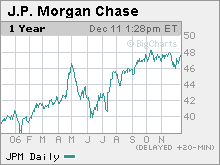 When J.P. Morgan Chase purchased Bank One in 2004, it also acquired the considerable management talents of that company's CEO, Jamie Dimon, who had turned around what was arguably the worst-run big bank in the country. Since taking the helm at J.P. Morgan, the brash Queens native has largely followed the same playbook he used at Bank One - installing new managers, meshing computer systems, and axing pricey outsourcing contracts. His efforts are paying off. Led by its robust investment-banking and wealth-management arms, the company is expected to report a 25 percent jump in earnings in 2006.
When J.P. Morgan Chase purchased Bank One in 2004, it also acquired the considerable management talents of that company's CEO, Jamie Dimon, who had turned around what was arguably the worst-run big bank in the country. Since taking the helm at J.P. Morgan, the brash Queens native has largely followed the same playbook he used at Bank One - installing new managers, meshing computer systems, and axing pricey outsourcing contracts. His efforts are paying off. Led by its robust investment-banking and wealth-management arms, the company is expected to report a 25 percent jump in earnings in 2006.There's more upside to the turnaround. Chris Davis, who owns 72 million shares at Davis Funds, points out that the company is made up of a collection of businesses that can grow faster than the global economy and have room to improve both market share and profit margins. A quick way to look at the potential is to compare the return on equity - a key measure of profitability - of J.P. Morgan Chase and Citigroup. In 2005, Citigroup's ROE was 17.5 percent while J.P. Morgan's was 10.5 percent. To Davis, the gap means that J.P. Morgan Chase has "significant potential" to boost its profits.
The stock sells for 12 times projected 2007 earnings, roughly in line with industry rivals Citigroup and Bank of America; it yields 2.9 percent. Assuming 10 percent annual revenue growth over the next several years and continued savings from the merger, Morningstar analyst Craig Woker figures shares are worth $61.
